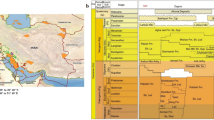Abstract
A gas field is a layered carbonate reservoir which mainly developed crack-dissolution hole. The reservoir heterogeneity is poor, and is influenced by the grooves and dense belt. The gas production profile test datum show that there have bigger differences in vertical stratification gas production, and the layered reserves producing degree is not even. So, firstly this paper applied pressure drop method and instability analysis method to calculate the dynamic reserves, and then, mainly use the pressure drop method to verify the reserves. On this basis, this paper evaluate the reserves producing degree from the area and vertical two aspects, and then find out the areas that are not controlled for drilling infill wells. There is an impermeable interlayer between M1 and M2 (M is a layer name), in order to calculate the production for each layer, we build up a model with two layers. So the flowing mechanism in the layered gas reservoirs without crossflow is analyzed and a closed circle boundary mathematical model considering skin effect established for calculate the production contribution of each layer, providing basis for potential tap** measures in this gas field.
Access this chapter
Tax calculation will be finalised at checkout
Purchases are for personal use only
Similar content being viewed by others
References
**, F., Wei, H., Xu, Q.: Analysis of dynamic reserve calculation in early development phase of nonhomogeneous gas reservoir. Gas Indust. 22, 87–90 (2002)
Wang, D., Wang, H., Li, Y.: Evaluation of use level of the tough reserve of ChangQing Gas Field. Gas Indust. 20(5), 64–66 (2000)
Wang, X., Liu, C.: Analysis of multiple-zone oil production capacity. Technol. Petrol. Drill. Product. 21(2), 56–61 (1999)
Liiu, Q., Wang, H., Wang, R., et al.: Influencing factors and calculation method of different-layer production of multiple-zone gas reservoir. J. Southwest Petrol. Univ. 32(1), 80–84 (2010)
Zhao, G.: Analysis of multiple-zone Gas Production Capacity Optimization in. China Geology University (2005)
Guo, P., Wang, J.: Study on Development Mechanism of Commingling Production in Low-permeability Gas Reservoirs (2010). SPE 130892
Jorge, A., Robert, A.: Production Analysis of Commingled Gas Reservoirs - Case Histories (2000). SPE 58985
Lolon, E.P., Archer, R.A.: New Semi-Analytical Solutions for Multilayer Reservoirs (2008). SPE 114946
Sun, H., Liu, L.: Exact Solution of Two Layer Reservoir with Crossflow under Constant Pressure Condition (2003). SPE 81043
Lefkovits, H.C., et al.: Allen. A Study of the behavior of bounded reservoirs composed of stratified layers (1961). SPE 1329
Wan, Y., Sun, H., Huang, W., Zhu, H., Zhong, S.: Analysis of production degree of multilayer gas reservoir in Sebei gas field. Gas Indust. 29(9), 58–60, 138 (2009)
Jia, A., Ninghai, F., Cheng, L., Guo, J., Yan, H.: Low-efficiency reserve evaluation and availability analysis of **gbian gas field. Petrol. J. S2, 160–165 (2012)
Tian, L., Mou, W., Wang, M.: Study on calculation method of dynamic reserves in early stage of water gas reservoir development. Sci. Technol. Eng. 16(15), 179–183 (2016)
Ren, D., Dong, J., Wang, Z., Wang, S., Xu, M.: Variation Rule and prediction method of well controlled dynamic reserves in volcanic gas reservoirs. Nat. Gas Geosci. 27(6), 1110–1115, 1133 (2016)
Xu, X., Hu, Y., Wan, Y., Xu, Y., Tian, S., Tian, Z.: Dynamic physical simulation of reserves production in tight sandstone gas reservoirs with high water cut and low permeability. Nat. Gas Geosci. 26(12), 2352–2359 (2015)
Author information
Authors and Affiliations
Corresponding author
Editor information
Editors and Affiliations
Rights and permissions
Copyright information
© 2022 The Author(s), under exclusive license to Springer Nature Singapore Pte Ltd.
About this paper
Cite this paper
Liu, Q., Zhang, Y., Wang, K., Jiang, W., Wei, L. (2022). The Computational Model of Dynamic Reserves Producing Degree in Paleocrust Gas Field. In: Lin, J. (eds) Proceedings of the International Field Exploration and Development Conference 2021. IFEDC 2021. Springer Series in Geomechanics and Geoengineering. Springer, Singapore. https://doi.org/10.1007/978-981-19-2149-0_76
Download citation
DOI: https://doi.org/10.1007/978-981-19-2149-0_76
Published:
Publisher Name: Springer, Singapore
Print ISBN: 978-981-19-2148-3
Online ISBN: 978-981-19-2149-0
eBook Packages: Earth and Environmental ScienceEarth and Environmental Science (R0)




